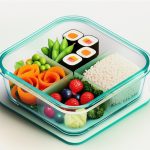Tired of all the confusing diet advice out there? Want to eat better but don’t know how to make it stick? You’re not alone! Healthy eating doesn’t have to be complicated. This guide gives you simple, practical steps to build healthy habits that you’ll actually enjoy. We’ll cover the basics – focusing on real food, managing portions, and making smart swaps in your everyday meals. Forget fad diets; let’s build a personalized healthy eating plan that works for you long-term. For a sample plan, check out this 7-day plan. Let’s get started!
Eating Healthy Today: Simple Steps for Sustained Energy
Let’s be honest: the idea of “eating healthy” can feel overwhelming. It shouldn’t be! This isn’t about strict diets or deprivation; it’s about making gradual, enjoyable changes that nourish your body and boost your energy levels. Think of it as a positive lifestyle adjustment rather than a temporary fix. We’ll focus on simple, practical steps you can easily integrate into your life. Ready to embark on this journey?
Core Principles for a Healthier You
The foundation of healthy eating is surprisingly straightforward. It’s not about complicated rules, but about making conscious choices that benefit your wellbeing.
1. Embrace Whole Foods: Consider whole foods the cornerstone of your diet. Fruits, vegetables, whole grains such as brown rice and quinoa, lean proteins like chicken, fish, beans, and lentils, alongside healthy fats from avocado, nuts, and seeds, are great choices. These foods are rich in vitamins, minerals, and fiber. These nutrients fuel your body efficiently, keeping you feeling full and energized without the extra baggage of processed foods.
2. Master Portion Control: This doesn’t mean starving yourself! It means paying attention to your body’s hunger and fullness cues. Eat until you’re comfortably satisfied, not stuffed. This helps maintain a healthy weight and prevents overeating. Learning to listen to your body takes practice, but it’s a crucial skill for long-term success. Registered Dietitian, suggests using smaller plates or bowls to help visually manage portion sizes.
3. Practice Mindful Eating: This is about slowing down and truly savoring your food. Pay attention to the tastes, textures, and aromas. This simple act helps you appreciate your meals more fully and prevents mindless snacking. Try putting your fork down between bites and chewing thoroughly. It’s amazing how much more satisfaction you’ll get from your food!
4. Limit the “Not-So-Good Stuff”: Processed foods, added sugars, and excessive sodium are often hidden in seemingly healthy products. Become a label detective! Read ingredient lists carefully and choose items with minimal processed ingredients. Cutting back on these will significantly improve your overall health. It’s often surprising how many “hidden” sugars and sodium lurk in everyday items like sauces, dressings, and pre-packaged snacks.
Actionable Steps: Making Healthy Eating a Habit
Now that we’ve covered the basics, let’s dive into practical steps to make these principles part of your everyday routine. Remember, it’s all about small, sustainable changes, not drastic overhauls.
Step 1: The Great Swap-Out: Gradually replace refined grains (white bread, white rice, white pasta) with whole grains (whole-wheat bread, brown rice, whole-wheat pasta, quinoa, oats). Whole grains are higher in fiber, which helps you feel fuller for longer and aids digestion. Studies show increased fiber intake can also improve gut health. It’s a surprisingly easy swap that makes a big difference to your energy levels and overall health.
Step 2: Rainbow on Your Plate: Aim for a colorful variety of fruits and vegetables every day. Their vibrant hues indicate a diverse range of vitamins and antioxidants, which are essential for boosting your immune system and protecting against cell damage. Don’t be afraid to experiment with new recipes and flavors. Consider adding a side salad to your lunch or dinner, or snacking on chopped vegetables with hummus. A good goal is to incorporate at least three different colors of fruits and vegetables into your main meals.
Step 3: Hydrate, Hydrate, Hydrate: This is often overlooked, but drinking plenty of water is crucial for overall health and energy levels. Carry a reusable water bottle and sip throughout the day. Dehydration can often manifest as fatigue, so adequate hydration is key. Some experts suggest aiming for at least eight glasses a day, but your individual needs may vary based on activity level and climate. Consider adding slices of lemon, cucumber, or berries to your water for added flavor.
Step 4: Smart Swaps for Drinks: Swap sugary sodas, juices, and sweetened beverages for water, unsweetened tea, sparkling water, or infused water. These simple swaps significantly reduce your sugar intake and empty calories, contributing to better weight management and overall health. You might be surprised how quickly your cravings for sugary drinks diminish once you make the switch. Try experimenting with different herbal teas or adding a splash of fruit juice to sparkling water for a refreshing alternative.
Step 5: Plan Ahead for Success: Prepare some meals or snacks in advance. This simple act ensures healthy options are readily available, preventing impulsive unhealthy choices when hunger strikes. Batch cooking on weekends can save you significant time during the week. Investing in airtight containers for easy storage and transport of your prepared meals is a good strategy.
Weekly Meal Planning Example:
| Day | Breakfast | Lunch | Dinner | Snacks |
|---|---|---|---|---|
| Monday | Overnight oats with berries and nuts | Salad with grilled chicken and quinoa | Baked salmon with roasted broccoli | Apple slices with almond butter |
| Tuesday | Greek yogurt with fruit and granola | Leftover salmon and broccoli | Lentil soup with whole-wheat bread | Handful of almonds |
| Wednesday | Whole-wheat toast with avocado and egg | Veggie burger on a whole-wheat bun | Chicken stir-fry with brown rice | Baby carrots and hummus |
| Thursday | Scrambled eggs with spinach and whole-wheat toast | Leftover stir-fry | Vegetarian chili | Greek yogurt |
| Friday | Smoothie with fruit and spinach | Leftover chili | Pizza with whole-wheat crust and veggies | Air-popped popcorn |
| Saturday | Whole-wheat pancakes with fruit | Salad with chickpeas and feta cheese | Grilled chicken salad | Berries |
| Sunday | Whole-wheat waffles with fruit | Leftover grilled chicken salad | Roast chicken and sweet potatoes | Trail mix |
Addressing Common Roadblocks
Time Constraints: Prep ingredients or entire meals in advance. Utilize slow cookers or one-pan recipes for easy weeknight dinners. Pre-chopping vegetables and storing them in the refrigerator can also save valuable time during the week.
Budget Concerns: Buy seasonal produce, which is often cheaper and fresher. Plan meals around less expensive protein sources like beans, lentils, and chicken thighs. Consider buying in bulk when possible. Frozen fruits and vegetables are also a cost-effective and nutritious option.
Lack of Motivation: Start small – focus on one or two changes at a time. Celebrate your successes, no matter how small they seem. Find a friend or family member to join you in your healthy eating journey for mutual support and accountability. Consider joining a support group or online forum for added encouragement.
The Long Game: Sustainable Healthy Eating
Remember, healthy eating is a journey, not a race. There will be bumps along the road. Don’t strive for perfection; strive for progress. Focus on consistency, not immediate results. Small, consistent changes over time yield the most significant and lasting benefits. Enjoy the process, and celebrate your successes along the way. You’ve got this!
How to Create a Personalized Healthy Eating Plan Based on Individual Needs and Preferences
Key Takeaways:
- Personalized eating plans improve adherence and lead to better health outcomes compared to generic diets.
- MyPlate provides a solid foundation for a balanced diet, but technology offers increased personalization.
- Individual preferences, including food likes and dislikes, are key to long-term success.
- Addressing time, cost, and motivation challenges related to meal prep is crucial for sustainable change.
- Professional guidance from a registered dietitian can significantly improve results and ensure nutritional adequacy.
Understanding Your Nutritional Needs
Before diving into how to create a personalized healthy eating plan based on individual needs and preferences, let’s establish a baseline. What does healthy eating really mean for you? It’s not a one-size-fits-all answer. It’s about fueling your body with the nutrients it needs to thrive, considering your unique lifestyle, preferences, and health goals.
Think of your body as a high-performance machine. Different machines need different fuel. A race car needs high-octane fuel; a lawnmower needs regular gas. Similarly, your nutritional needs depend on your activity level, age, health conditions, and even your genetic makeup. For example, athletes need more protein than sedentary individuals, and pregnant women have increased micronutrient needs.
Building Your Personalized Plan: A Step-by-Step Guide
-
Assess Your Current Eating Habits: Start by honestly evaluating what you currently eat. Keep a food diary for a few days – it reveals patterns you might not notice. Record everything you eat and drink, including portion sizes and times of day. Several apps are available to help with food tracking.
-
Define Your Goals: Are you aiming
- Bento Box Glass Offers Practical, Eco-Friendly Meal Storage - December 16, 2025
- The Best Bento Box Price For Your Perfect Packed Lunch - December 15, 2025
- Bento Box Shopping Tips for Smart and Stylish Lunch Prep - December 14, 2025










